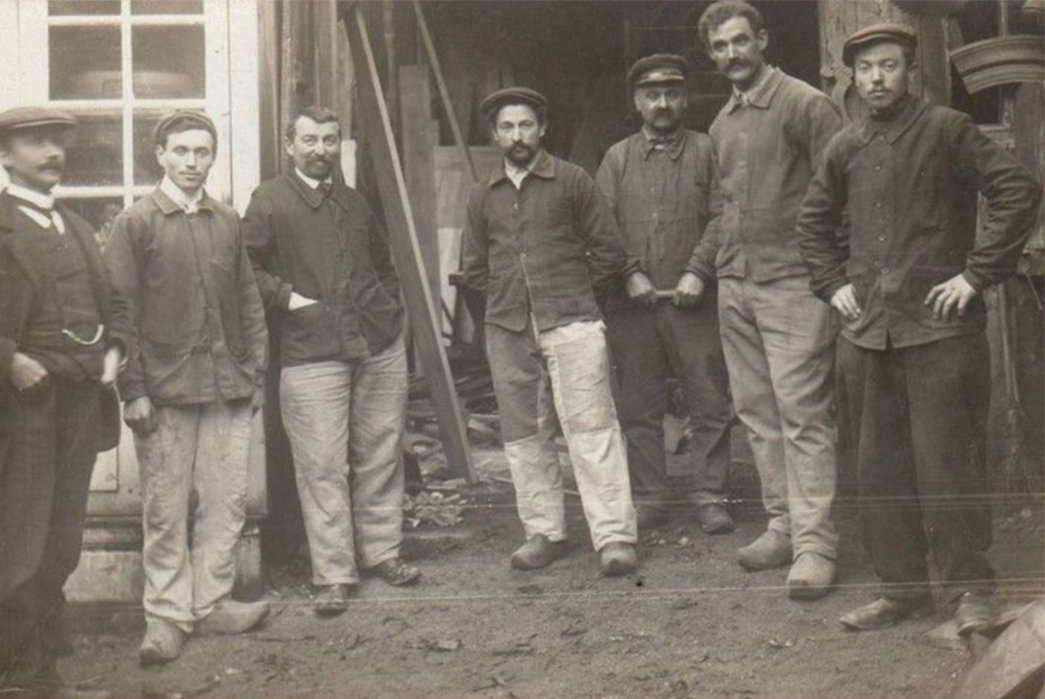- Heddels
- Posts
- Oct 15 - Moleskin History - Revolvr
Oct 15 - Moleskin History - Revolvr
Together with
Digging into Moleskin – Textile Tales
A look into the history, structure, and uses of one of workwear's softest and hardest-wearing textiles — moleskin.
Young Lee and James Smith

When talking workwear, the usual images that come to mind are denim, canvas, and heavy leather boots. An accurate picture in the United States, but across the ocean in Europe, specifically France, workwear had a slightly different look with the prevalence of a fabric known as moleskin.
Moleskin isn’t actually made of mole’s skin, but heavy cotton. Its name is due to the fabric having a soft brushed hand, which is similar to the skin of the subterranean mammal. While it isn’t seen as often as denim or canvas, for those who’ve felt moleskin, it’s almost a unanimous opinion that it is one of the softest and hardest-wearing fabrics out there. So let’s dive a little further into moleskin, its history and modern uses
The History of Moleskin

1974 west German moleskin field blouse via Blue Horse
The origins of moleskin are a little hazy but its uses can be traced back to medieval Europe, where the fabric was first made for farmers and hunters who needed clothing that was comfortable, warm, durable, and wind-resistant.
Fast forward to the nineteenth century as various industries began to develop in France, steel workers were wearing moleskin pants and aprons to protect themselves from splashes of molten metal. As more industries continued to grow in France, the use of different fabrics, including moleskin, for workwear increased.
Soon not only were there different variations of the fabric being used in many different trouser and jacket designs but moleskin (and other fabrics) were being dyed different colors depending on the industry it was being used in (see: bleu de travail)

Bleu de Travail moleskin workwear via House of Celeste.
For a portion of the mid-twentieth century, the West German Army utilized moleskin in their uniforms. Like the indigo-dyed moleskin used by French mechanics and the black moleskin used by carpenters, the West German Army chose a dyed moleskin to match the olive/gray colors used in the military.

Moleskin uniforms in the West German Army
/ In Partnership with Revolvr /
That’s right, that Filson Tin Cloth 24-Hour Briefcase and Freenote Cloth Bodie Plaid among hundreds of more high-quality items could be yours if you’re the lucky winner of our Revolvr Win Your Cart Giveaway.
Just enter your name and info here and then fill your cart with up to $750 worth of boots, jeans, outerwear, and whatever else your heart desires and you could be the lucky winner who gets it all shipped to their door for free.
Fill that cart before October 20 and click here to enter at Revolvr.
The Structure of Moleskin

Moleskin is technically a fustian fabric that is used to classify shorn heavy cotton fabrics like corduroy and velveteen. It’s tightly woven with a satin weave with both warp and weft typically the same color. One side is shorn and/or brushed to create the soft nap moleskin is known and named for. This is also known as ‘peaching’ due to the light fuzz on a peach.

Moleskin close-up via S.E.H. Kelly
Like all other fabrics, moleskin fabrics can vary in density, yarn size, and also in softness, depending on whether it is shorn and/or brushed. Moleskin’s wind resistance and warmth can be attributed to the denser weave and brushed nap.
How Moleskin is Used Today

Styling of Moleskin French workwear jackets via Knickerbocker and Les Indispensibles Paris.
While not as common as other hardy cotton fabrics, moleskin has picked up in popularity in the last decade or so. Vintage French workwear and modern productions from longstanding labels like Le Laboureur, Le Mont St. Michel, and Vetra thrust moleskin into the popular fashion zeitgeist.
Moleskin’s history means it is also used by heritage labels on both sides of the hemisphere. It can be used whenever a hardy fabric is part of a garment’s design and is even more appropriate when a brand wants to inject some European flair. Here are a few examples of quality moleskin garments in our niche today:
What did you think of today's newsletter? |






